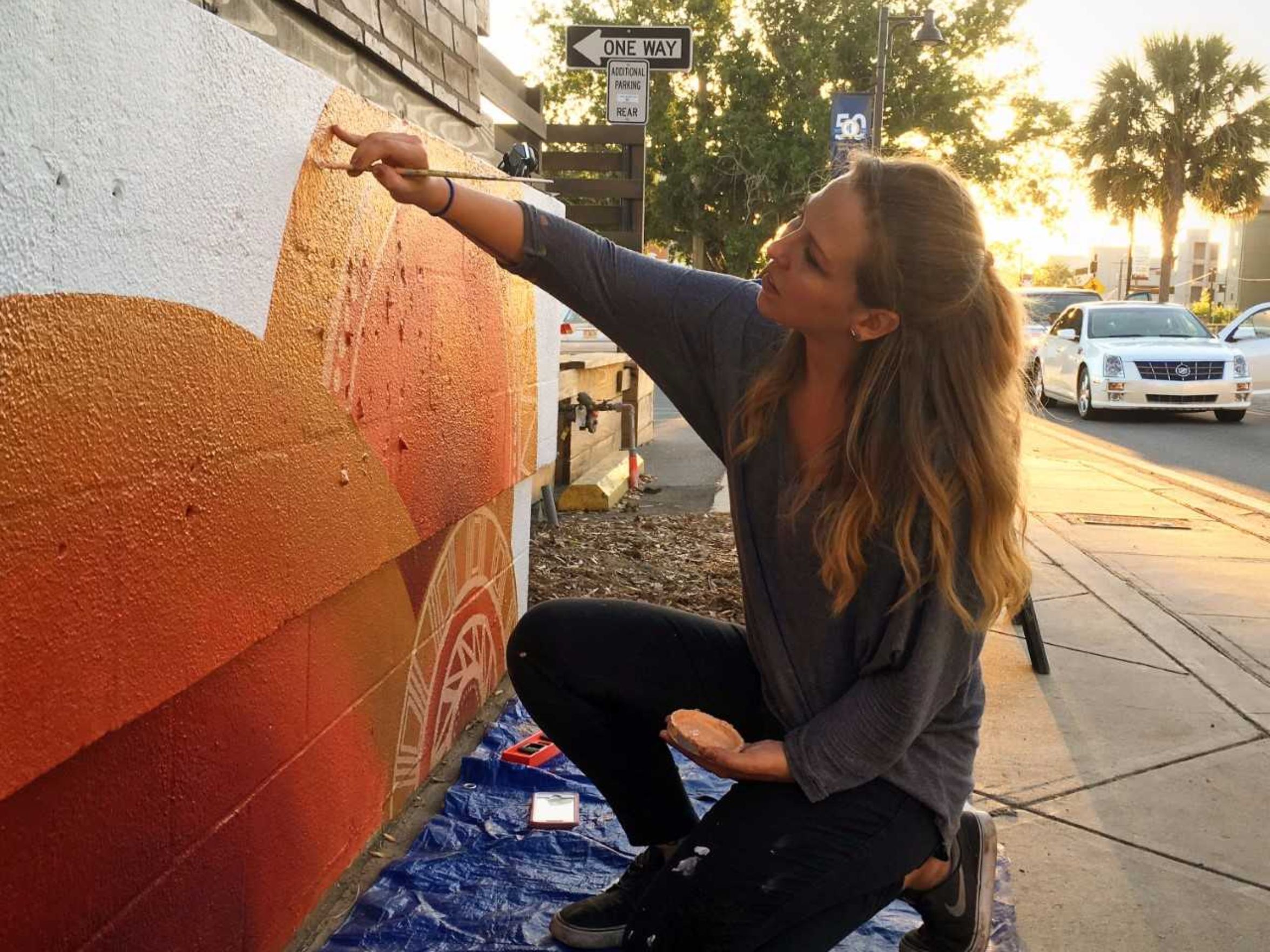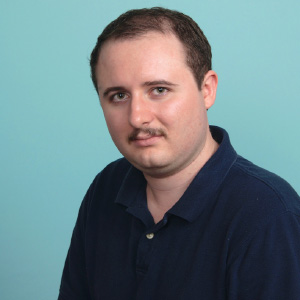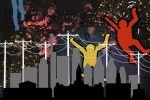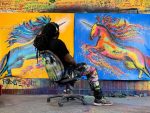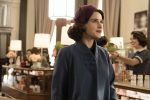There are plenty of students with big dreams. Sarah Painter (yes, that’s her real name), a senior at Florida State University, may have taken that phrase a bit more literally than most. While the Studio Art major is perfectly comfortable behind an easel, she’s known around Tallahassee, Florida, for being the artist behind a number of large murals around the city.
Originally an Architectural Science major at the University of South Florida, Painter transferred to FSU after freshmen year in order to pursue her true passion. A fan of music, nature and travel, she has a love and talent for both realist and abstract art. She’s the reason a giant Jimi Hendrix has sprouted from the Sidebar Theatre in Tallahassee and has been the star of numerous live painting-as-performance-art events around the U.S.
Daniel DeAngelo: So, how often do you get asked about your name?
Sarah Painter: Very often. When people find out that I do art and my last name is Painter, normally they ask, “Is that your real name?” They think I use that as an artist name. So, pretty often I would say.
DD: You don’t think your name might have inspired you even a tiny bit?
SP: Honestly, not really. I always did creative stuff growing up, and even as a kid people would make jokes because I was the artistic kid in the class and my last name was Painter, but that was definitely not a pushing point at all. It’s really just a happy coincidence.
DD: When did you start painting?
SP: I started painting, actually taking it seriously, my freshmen year of college. I dabbled a little bit in high school, but not too much. I really didn’t like painting too much then because it’s a harder medium. I was more into drawing and whatnot, but once I felt like I’d done what I could with drawing, I wanted to expand into painting because you can do more with it, like larger scale pieces. I would say I started getting into it around 2012, so about five years ago.
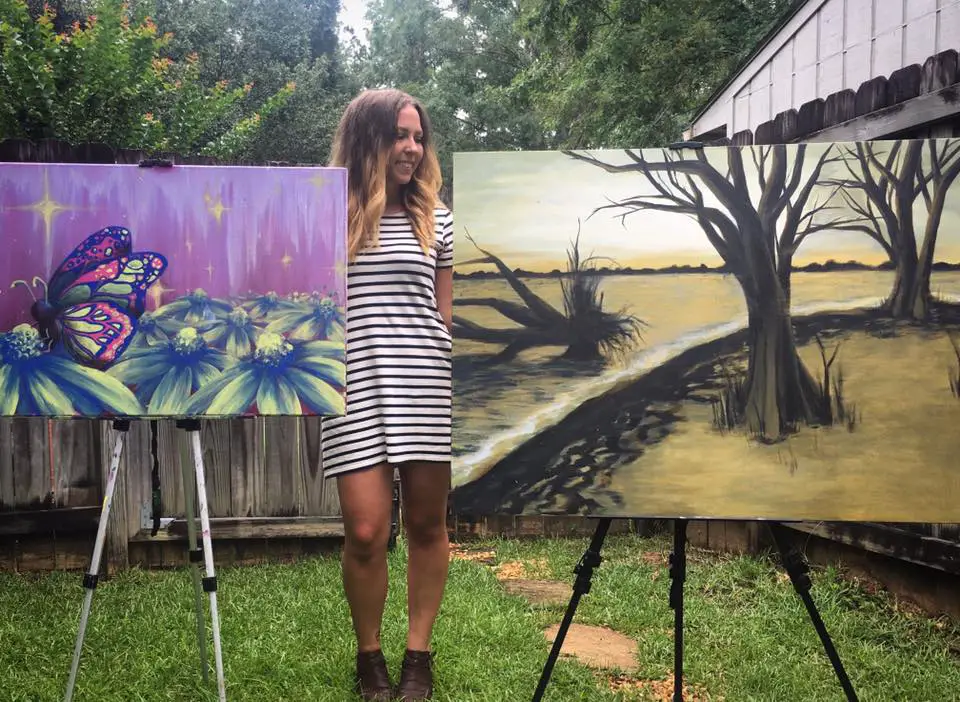
DD: Since you started painting seriously, how many pieces have you created?
SP: Honestly, countless. I try and keep track, but a lot of times I give them away or forget to take a picture of them or they get lost. Hundreds easily, and it also depends on what you consider a piece. Is a sketchbook page a piece, or only what’s on canvases? Just counting canvases, hundreds. I make art every single day, and there’s no way I could keep track of that. It’s funny, sometimes I’ll come across an old picture I took of a piece, or a friend will send me a picture of a piece I had done for them, and I’ll have forgotten that I’d even done it. And then there are classes too; I go to school for art, and you’re required to do a lot of it in those. There’s no way I could guess a number.
DD: Why did you initially choose to major in Architecture before transferring to FSU?
SP: A lot of kids, when they first go into college, they don’t really know what they want to do. I was one of those kids, and I wanted to do something that I thought I would be good at. I knew I was a creative person and very visual, but I wanted a degree that was kind of practical. I wanted to get a degree where I knew I could get a job with it. So, Architecture kind of seemed like a happy balance. There wasn’t anything besides that, it was just kind of like, “Alright, let’s hope this works.”
So, I went into Architecture, and I think I changed it my second semester. I changed it to Graphic Design and did that for another semester. In Graphic Design, I was required to take an art class and I was like, “Man, I just really need to do art.” I just needed to stop denying it I guess. There’s a stigma with art majors and whatnot. A lot of people don’t think it’s something you can do seriously, but the more I looked into it, the more I explored I realized art is what I wanted to do and that is where my heart lies.
If you work hard and utilize your strength, it does work out and it is something you can make into a career. The whole thing about being an artist is that you create your career path. It’s not a handbook that you follow, it’s not a series of steps you take and then you become an artist. It’s you being creative, being actively engaged in the world around you and the opportunities that are there and making it happen. It’s creating something that hasn’t been laid down before. That’s what I think a successful artist is—not following in someone’s footsteps but creating something new. If you have that mindset, then it works out, but if you don’t, well, you can’t just get the degree and go have a job. You have to be very innovative.
DD: You decided to change your major after seeing Professor Carrie Ann Bade speak, correct?
SP: Yeah, that was definitely a selling point for flipping my major. I’d thought about it and considered it, but after I saw her lecture, it was a light bulb moment where I had no hesitation, no doubt what I had to do. So, yeah, I would definitely mark that as a turning point.
DD: Was her being an FSU professor the main reason you transferred to that college?
SP: No, that wasn’t really related too much. It was in the back of my mind, but I’m from Tallahassee, and originally it was just to save money. Once I got here, I really liked it and didn’t even consider going back.
DD: Could give us an idea what it’s like to be a Studio Art Major?
SP: Well, at FSU at least, it’s a very close-knit program. I would say all the artists really work together a lot and the faculty is really nice too. You can tell they really care about their students and they all act as mentors. They’re not just there to teach a class and go home; they’re there to see what their students’ needs are and give advice about how to transition into the working world. I don’t know if all programs are like this, but it really is a comforting feeling going to class and having the support of your peers.
Also, studio art classes tend to be very long, about two-and-a-half hours. So, you’re in class for a long time and there’s a lot of working on projects outside of class. You’ll find yourself in the painting lab late into the night or for long hours in the day, and when you see other students doing the same thing, you tend to bond with them.
DD: No second thoughts since changing your major?
SP: I really haven’t had any. There are a lot of things I’m unsure of, but choosing to commit myself to art is something that I’ve never second-guessed. The only time I might have second-guessed myself is as to what specifically I should do with my art, but being an artist is never something that I’ve second-guessed.
DD: On your Facebook page, you say your art is inspired by a “love for music, nature, history and travel,” can you elaborate on that?
SP: I would say that those are things that are natural interests of mine. Those are the things that my day-to-day life is filled with. I travel to go to a lot of concerts and I try to find art opportunities while I’m traveling. I’ll go to music festivals and do live art. I think it just comes naturally; those are my interests and it is reflected in my art. I think you learn the most from the things that you are inspired by. Really, I would say that those are personal interests that translate into my art because art is always a reflection of yourself, whether the artist intends it or not.
DD: Is there a particular artist or work that inspires you?
SP: I’m inspired by anyone who lives their life as an artist, even if their work isn’t something I’d make. I like seeing variety and I appreciate differences in artistic choices. There’s not one piece that I can always go back to. There is one artist right now who I’m kind of fixated on; his name is Sean Yoro. He goes by Hula and he’s a mural artist who does really large-scale pieces, typically of women, and he’s someone who I’m really inspired by as of late.
Shepard Fairey is another one because I like how he implements his art. He always has some kind of message and he’s really politically involved. He did Obama’s 2008 campaign poster, has done a lot of work with musicians and touches on social issues a lot through his work.
DD: Do you have a favorite work from another artist?
SP: That’s a hard question to answer because there are different pieces I like for different reasons. One of my classic favorites, one I found myself going back to ever since before I really pursued art at all, is Vermeer’s piece, “Girl with a Pearl Earring.” That was made in the early 1600s if I’m not mistaken, but I really love that piece and am fascinated by it. There’s a lot of history behind it and I just think it’s a really timeless piece of work.
DD: When FSU News interviewed you, you described your style as abstract, but added that you were starting to incorporate both realist and abstract elements into your work. Can you expand on that?
SP: When I first started doing artwork, before deciding to pursue it seriously, I just found myself making art that was really abstract in nature. I used a lot of unrealistic colors that were very vibrant and made a lot of non-subject matter kinds of things. What really inspired me to shift my style was when I got into classes and I decided, “Okay, I’m going to be an artist. I’m pursuing this.” I wanted to be good in a technical sense because if you have technical skills, no matter what style you choose to do in the future, you’ll be able to do it correctly and intentionally. I wanted to be good at it if I ever needed to be. Then I kind of fell in love with realism for a long time.
Stopping and looking at the body of work, I realized that half is very abstract and then half of it is very realistic. It would be hard to tell that it was even by the same artist. I needed to find a way to incorporate these two loves of mine, even though they are very much on opposite ends of the spectrum. So, that’s what I’m working on now; trying to take realistic elements, but in a way that looks abstract or surreal. If you could imagine a piece by Salvador Dali, a lot of his work is very abstract in nature. You can tell it’s not real-life elements bring painted, but he paints it so realistically that he makes unreal images look like something that could be real.
DD: I understand you prefer working on murals and live painting to painting in a studio.
SP: To a degree. I like doing live painting and murals and stuff because you are out with other people in the community. I’m a pretty social person, so I like being outside, but I do love painting alone in a studio by myself, too. I really like my alone time because it’s a time to reflect on things. It’s very peaceful and it’s definitely something I do often. I wouldn’t necessarily say I like one more than the other. It might seem that I like live painting and muraling more because that’s what people see me do, but really, I’m working alone in my studio almost just as often.
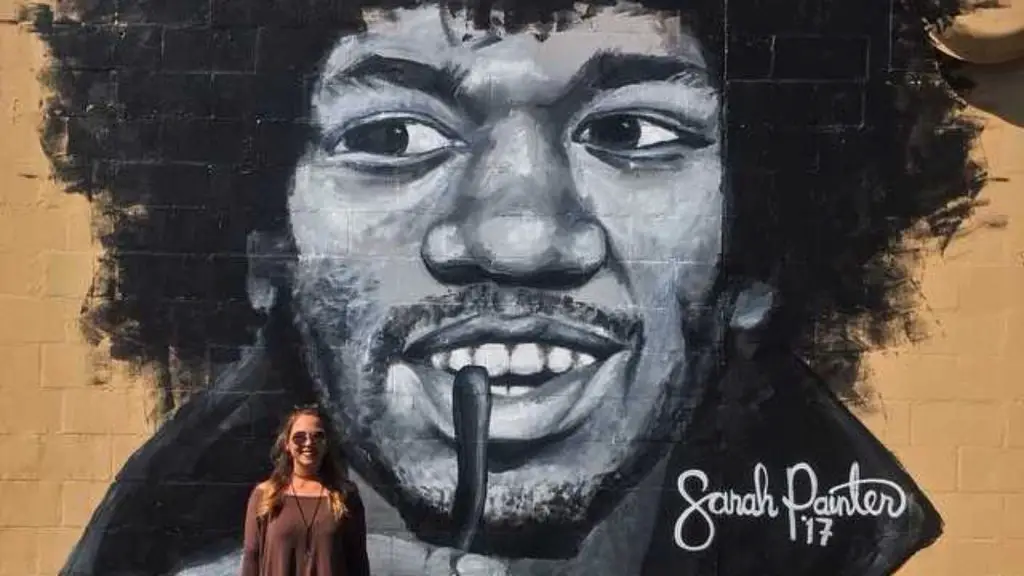
DD: Can you describe the experience of painting in front of an audience?
SP: When in front of people, you can’t help but be aware of it, especially if you’re doing a painting from a blank canvas to a completed piece; there’s a sense of pressure put on you and it has more of a performance aspect. You’re very aware of it. It’s like, “Okay, I have this time frame to complete this piece,” so when you have that in your mind, it’s a much different thought process as opposed to when I’m alone in my studio making pieces that I might not ever show anyone.
Also, when you’re out doing live painting, depending on the setup, I really like when other artists will come up and talk. A lot of the time, it’ll be artists who are very shy and maybe never show their work. For whatever reason, they’ll feel comfortable showing me their stuff or asking questions. I think it’s a good opportunity for artists to connect with each other, and also a good opportunity for me to explain my process a little bit. It leads to a better understanding and a better appreciation for the viewer, as opposed to just seeing a finished piece hanging.
DD: Do you have a favorite piece you created?
SP: Yeah, I do, actually. There’s one piece that I worked on for a long time and I took it with me to a lot of places. Last year, I did a lot of traveling for music festivals and to do live painting, and I took it with me along the way. I don’t really have a name for it, but it’s a big sunflower in the middle that creates a mandala above you. I really put a lot of time into it and a lot of patience. It wasn’t a commissioned work, just something I made for me, and I really kind of fell in love with it along the way. When I stop and look at it, I remember all the places where I’ve been as I worked on it. It went to Arkansas with me, it went to Oklahoma with me, and I think of all the times I had with it. It’s an inanimate object, but I really fell in love with it in a way, and I think it looks nice aesthetically. All the memories and the process of making it are what makes it so special to me.
DD: Can you tell me a little about any pieces you are currently working on?
SP: Right now, what I’m doing is a lot of planning for larger-scale pieces or murals. So, a lot of what I’m working on now is really all just in Photoshop, where I’m mapping it onto a wall. I haven’t really started painting it yet; I’m just making proposals and mock-ups.
There’s this place in Tallahassee that I can’t name, but I’m working on some murals for them that are very large scale. It will be the largest project I have ever done and they want it in the next month, so this is about to happen. I’m contracting out to other artists to try and feature some of their work on it, too. More mural projects are what I would say I’m working on now; one very large-scale mural that I’m very excited about.
DD: Do you have anything in mind for the future?
SP: Well, I graduate in the spring, and that’s just with my undergrad. Right now, I’m looking into master’s programs. I’ve met with a couple different admissions officers to see what they’re looking for. I’d really like to go get my MFA somewhere outside of Tallahassee, and I’m still trying to decide where. I’d like to continue doing murals, too. That’s really the avenue I want to take and I want that to reflect in the work that I do for my MFA. Whatever school I can get into that would allow me to keep on doing large-scale public work is definitely the path I am looking for. After that, I really want to get my Ph.D., but one thing at a time.


